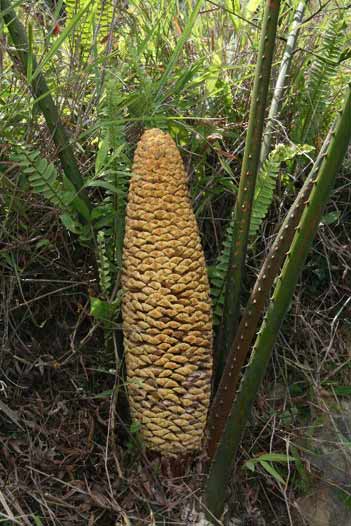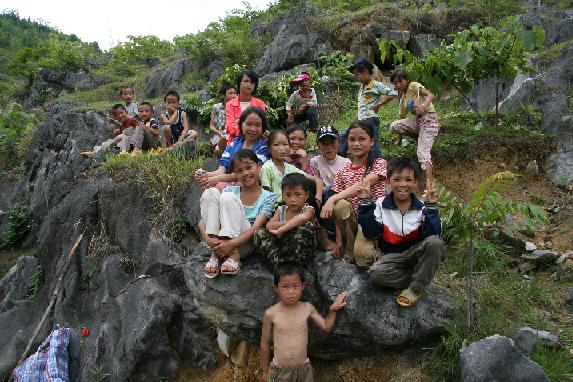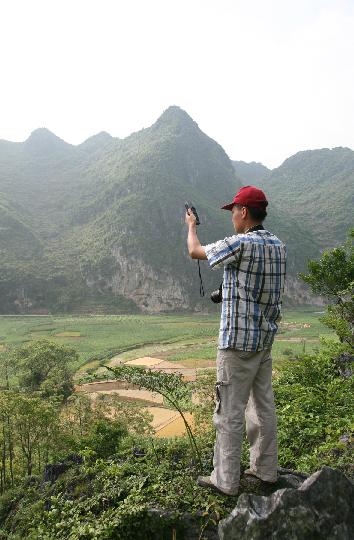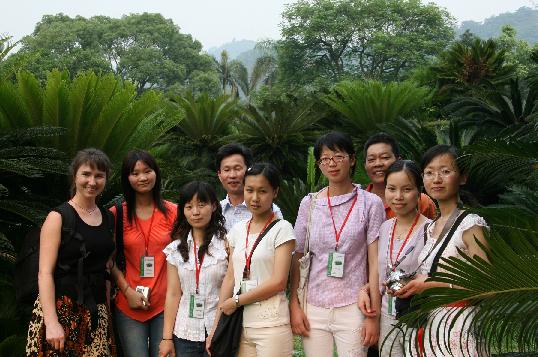Our Chinese Cycad Connection
Santa Barbara-Based Couple Study Rare Plant and Help Schools in China

Earlier this year, Lotusland research associate Jeff Chemnick traveled with his wife, UCSB marine science and policy advisor Satie Airame, to China in search of rare cycads, an ancient plant that still thrives there. Specifically interested in Cycas debaoensis, the couple, along with a research team, went to the remote Fuping Valley in Guangxi, which is the only place this species of cycad grows.
Most of the forest that the plant used to grow in is now cut down, but people left the cycads alone, since they are considered “attractive and ornamental.” Villagers made the decision to protect and conserve these plants by starting a nursery with cycad researchers, and when the plants grow, the villagers return some to the wild, hand-pollinate others to produce more seeds, and sell the rest for profit. In the future, the Guangxi Forestry Department hopes to take over the nursery in order to better promote conservation and appreciation of the uncommon plant.
The researchers’ goal was to continue with an international conservation project that was created in 1999 by Liu Nian and William Tang to address both the needs of the Fuping Valley residents and the cycad species. Chemnick, Airame, and the rest of the team surveyed the rare species of cycads, shared knowledge with Chinese researchers, and helped the Cycad School, which is the only structured education in the area, and has 200 elementary-level students who all come from farming families.
Over the years of research in the Fuping Valley, relationships have strengthened between the scientists and the locals, and funds have been given to the school for building and improvement. The research team this year donated two computers to help teachers and students gain access to the internet.
As for their plant studies, the researchers studied the population of Cycas debaoensis, mapping the locations of each plant, identifying the sex of each plant, and measuring the length of each leaf. With this information, villagers and scientists can keep track of how many plants exist, which will also help in knowing whether there is illegal collecting of the plant in the future.
Recently, Airame answered a few questions about the trip.

What threats are there to cycads in China, and worldwide?
The main threats are, one, destruction of native vegetation due to logging, agriculture, and urbanization, and, two, removal of plants from the wild for (generally illegal) sale to collectors worldwide. All cycads are listed by CITES (Convention on International Trade in Endangered Species of Wild Fauna and Flora). Most are listed as Appendix I or II. As the CITES website explains, “Appendix I includes species threatened with extinction. Trade in specimens of these species is permitted only in exceptional circumstances. Appendix II includes species not necessarily threatened with extinction, but in which trade must be controlled in order to avoid utilization incompatible with their survival.”
Although most trade of wild collected plants is illegal, some collectors continue to buy plants on the black market anyway. Because many cycads are rare and beautiful, they are coveted by collectors.
Why is it important to keep this species safe? Why are cycads important?
Cycads come from an ancient lineage of plants, dating back to the time of the dinosaurs. They are living fossils – and serve as a window into the past. According to Wikipedia entry on cycads, the cycad fossil record dates to the Early Permian, 280 million years ago, and some may even date to the late Carboniferous period, 300 to 325 million years ago.
Cycads, which once were more widespread, are now restricted to relict populations where they persist. Cycads are most common and diverse in South Africa, Australia, Mexico, China, and Vietnam (which accounts for 70 percent of the world’s species) and also occur in various other places throughout the tropics. Only one species (Zamia integrifolia) is thought to be native to the U.S. and it occurs in Florida and Georgia.
What would familiarize people in Santa Barbara with cycads? We plant them in our yards, right?
Cycads are used for landscaping in Santa Barbara, other parts of Southern California, and other warm temperate and tropical climates. Cycads are distinctive ornamental plants with wide appeal. They look a bit like palms, but are not related. Ganna Walska Lotusland, the private botanic garden in Montecito where my husband works, maintains an exceptional cycad collection. [You can see these cycads on one of their daily tours.]
Other collections of note are the Huntington Garden, Berkeley Botanic Garden, and Quail Botanic Gardens. Another private garden, the Montgomery Botanic Garden in Miami, focuses on palm and cycad research.

Was this your first time there? How many times have people visited in the past?
This was our first visit to China. We were thrilled to be a part of this research expedition because, as invited researchers, we were able to enter areas of China that are not often on the tourist path. We met many interesting and kind people in remote villages. Few people spoke any English (we had translators) and some had little prior interaction, if any, with Westerners.
Researchers have been engaged in the Cycas debaoensis project for many years. Scientists from Florida (William Tang) and Thailand (Anders Lindstrom) went to Fuping Valley, Debao County, several times before our trip. These scientists set up a cycad research program to monitor the rare Cycas debaoensis.
First, the researchers surveyed the cycad population and numbered and mapped the plants. The entire plant population occurs on one hillside in Fuping Valley – not an unusual situation for relict populations of cycads. During our visit in May, we conducted a survey to relocate the numbered plants and verify their locations on the population map, and identify new plants.
On a previous trip several years ago, scientists started a cycad nursery in a small village near the wild population of cycads. When the cycads in the nursery mature and begin to produce cones, local people pollinate the cones and plant the seeds back into the local plant population. Some plants from the nursery can be sold to bring funding to the local village.
The scientists also donated funding to help build and supply The Cycad School because the scientists believe that educating children about the cycads and other species will help the children learn how to become good stewards of their local environment. On this trip, we donated two computers to the school and brought pencils for the children. Lots of kids in Fuping Valley now have University of California, Santa Barbara pencils.
Are the Chinese appreciative of your work?
The Chinese were very appreciative of our work. During the first week of our visit, we participated in a conference about cycads at Zhongkai University of Agriculture and Technology in Guangzhou (Guangdong Province). All foreign scientists made presentations about cycads or, in my case, the value of biodiversity. My husband Jeff Chemnick gave a talk about cycads of Mexico (he is an expert on that subject).

Chinese scientists also presented their work on ecology, genetics, tissue structure, and taxonomy of cycads. We shared and exchanged ideas with Chinese scientists and students from the university. University students served as our translators and worked with us to complete the surveys in the field (Fuping Valley, Debao County, Guangxi Province). I worked with an intelligent and gracious young Chinese lady by the name of Zhou Li Ping. Jeff worked with an enthusiastic and outgoing man called Wu Zhi (but we called him Nick). Both were graduate students at Zhongkai University.
Our work in Fuping Valley, near the border with Vietnam, was much appreciated by the local people. In fact, we were greeted by children of the village and a pathway of colorful flags in honor of our arrival. Our interaction with the local people helped to reinforce the importance of their natural and cultural heritage and, in a small way, promoted goodwill between China and the U.S.



